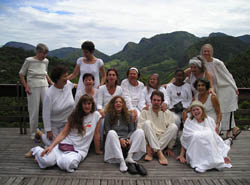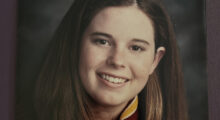 This is the second of our two-part interview with Silvia Nakkach, an innovative, award winning composer, multi-instrumentalist, voice culturist and author. Her specialties include music to aid in the healing process. Founding director of the Vox Mundi Project, an organization dedicated to the research, education, preservation and performance of sacred vocal arts, Ms. Nakkach teaches her students the art of sound healing. In this interview, she tells SevenPonds a little about her practice.
This is the second of our two-part interview with Silvia Nakkach, an innovative, award winning composer, multi-instrumentalist, voice culturist and author. Her specialties include music to aid in the healing process. Founding director of the Vox Mundi Project, an organization dedicated to the research, education, preservation and performance of sacred vocal arts, Ms. Nakkach teaches her students the art of sound healing. In this interview, she tells SevenPonds a little about her practice.
Antal: How do people make use of your music in a therapeutic setting?
Silvia: There is an article on my website called Devotional Music Therapy, and Music at the End of Life, which is the same, with all the information. It’s a chapter from my book called Music Therapy at the End of Life.
Antal: We’ve covered groups that played crystal bowls in the past who reach a resonance and soothing sound that way. What do you think about crystal bowls?
Silvia: Not in that plane, I don’t play them. I’m a musician, my students are mostly improvisational, very multi-cultural, we always ask, “What would you like to hear now?” No, I don’t want to hear that thing, I would like to hear some harp. Yes. “Would you like to hear some drums?” No. My students have to learn a lot of music. I like the Tibetan bowls, the bowls that are made of metal, but I don’t like crystal bowls, they generate all kinds of pain, can cause suffering. We play very soft music at the end of life.
Antal: Do you work with the hospice and care teams?
Silvia: We collaborate with hospice and the hospital in their treatment regimen. You have a meeting with them and ask them how long and you enter into the room for as long as the patient wants or the doctor wants. There’s no formula. It’s very important that we stay very sensitive to the dictates of the room and the flow. If there’s a patient nearby then we can’t play too loud. If the doctors are performing a procedure or if the patient is on a certain kind of medication, then we shouldn’t play at that time. We’re a part of the process, and we have to respect that. We can’t ever impose anything.
Antal: You’ve pioneered the practice of something called Yoga of the Voice. Can you tell us a bit about that?
Silvia: Yoga of the voice is a system of, a systemic approach to free the voice and self-expresssion of music and healing modalities. It combines ancient singing, chanting, music therapy, and works with the breath, works with concentration, works with the body. We go through Indian music, which is by the Rajas. We incorporate the use of sound vibration, and integrates many purposes to free the voice, free the mind, obtain a sense of selfe and learn a part, learn a repertoire, learn a state. But it’s the practice, a system that I developed all designed to free your voice and your self. It starts one way and ends another way, a system of sound, voice and movement.
Antal: Well, thank you so much for your time, it’s been an honor.
Silvia: Of course, Antal.
Antal: Do you have any final words for our readers who might be interested in learning about sound healing, or music therapy?
Silvia: My advice is to be in music. Listen to music. Sing, move and practice yoga. Meditate at least once every other day for 21 minutes; that’s very important. Do what you have to do to clear your mind and empty yourself. And then your whole consciousnes, your conscience on how to help people will be illuminated. Listen to more music, sing more music and try to do it every day. And remember to meditate, at least every other day, so your mind becomes in the necessity of the mind. Music and healing. These can help each other.
Antal: Again, thank you so much.
Silvia: My pleasure.
- Read about a group of women who play crystal bowls in synchronicity with Sacred Geometry.

 What is the Nature of Sound Healing? An Interview with Silvia Nakkach, Part 2
What is the Nature of Sound Healing? An Interview with Silvia Nakkach, Part 2




 Funeral Home Owner Chris Johnson Spending Halloween in Jail
Funeral Home Owner Chris Johnson Spending Halloween in Jail
 Our Monthly Tip: Toast a Loved One with a Personalized Glass
Our Monthly Tip: Toast a Loved One with a Personalized Glass
 My Cousin’s Death Taught Me the Meaning of Life
My Cousin’s Death Taught Me the Meaning of Life














